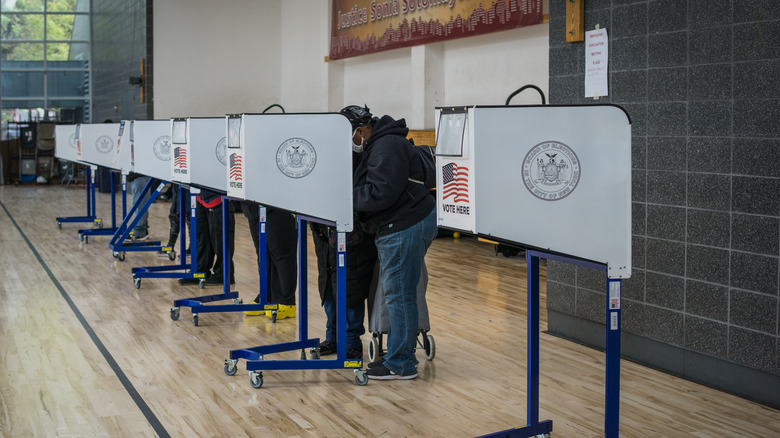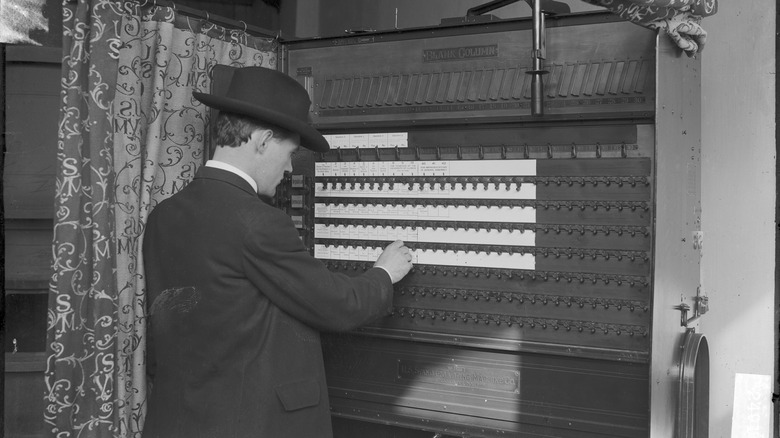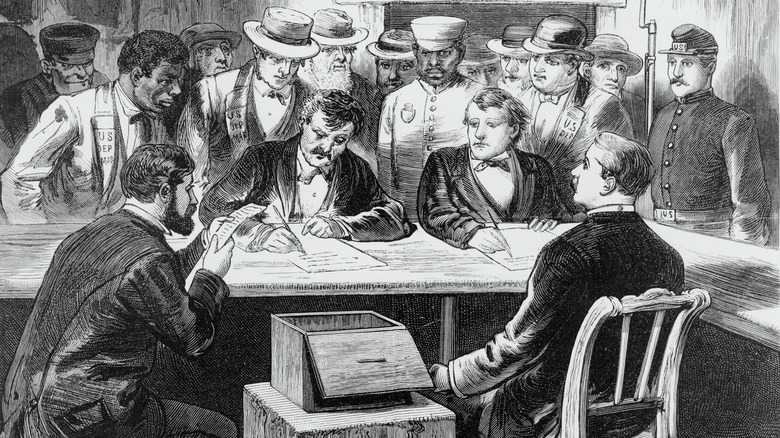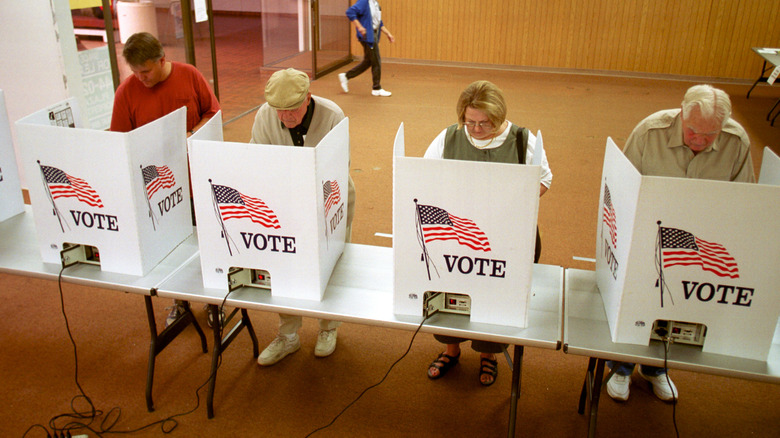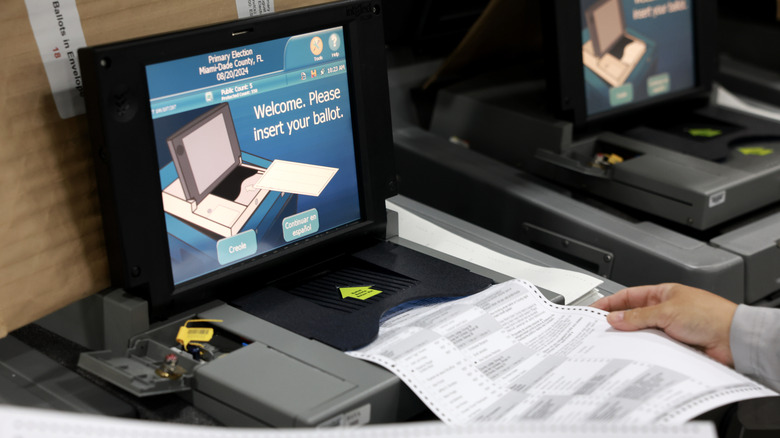How Voting Machines And Election Technology Have Evolved Throughout The Years
The U.S. presidential election is among the world's most avidly watched political spectacles, and come November 5, 2024, approximately 244 million eligible American citizens will have the opportunity to vote for a presidential candidate of their choice. The results of this election will have a lasting impact on the people of the U.S. and across the world.
The bulk of the votes during the 2024 U.S. Presidential Elections will be cast using electronic voting machines. However, the type of voting machine you may encounter will depend on the state or jurisdiction you're registered to vote. This is because, surprisingly, the U.S. has yet to agree upon a common standard for electronic voting machine types. Today, voting typically occurs through hand-marked paper ballots, Ballot Marking Devices (BMD), Direct Recording Electronic Systems (DRE), or hybrid voting machines.
Data from Verified Voting indicates that an overwhelming majority of the voting jurisdictions in the U.S. (69.8%) will use hand-marked paper ballots as their election-day voting choice for the 2024 Presidential Elections. These devices are followed by the Ballot Marking Devices, which are likely to be used by roughly 25.1% of jurisdictions. A handful of jurisdictions — approximately amounting to 5% – also use the much rarer Direct Recording Electronic (DRE) voting system.
Early history of voting in the U.S.
The first presidential elections in the history of the United States were held from 1788 to 1789, long before any of the modern voting methods were discovered. In fact, for almost half a century since the first elections, only white men were allowed to vote, that too in a very public and vocal manner known as the viva voce or voice voting. The process involved voters shouting the names of their candidates out loud.
The earliest record of a paper-based ballot system in the U.S. dates back to 1888 when Massachusetts State adopted the paper ballot system. Known as the Massachusetts Ballot, it was heavily inspired by an Australian election law enacted in 1856. This voting system, for the first time, also let voters privately cast their votes – a system in use to this day.
The year 1888 saw the genesis of two completely new voting systems that would go on to become the dominant methods of casting votes in the U.S. The first of these is the Mechanical Lever Machine. First patented by Jacob H. Myers of New York, the functional variants of these machines came to be known as the Myers Automatic Booth. This happened after Myers joined with another inventor, Alfred J. Gillespie, and formed the Automatic Voting Machine Corporation. The first demo of this machine was done in 1892 at Lockport, New York.
The second innovation was a punch card system patented by statistician and inventor Herman Hollerith. Herman's punch card system was not intended to be used for elections but was designed to tabulate data from the 1890 census. Several decades later, the punching technology pioneered by Herman would go on to become the most widely used method to cast votes in the U.S.
How did 19th century Americans vote?
Between 1800 and 1807, voters in New Jersey could write the name of their candidate on a piece of paper, and place the same inside a ballot box. However, even these methods were not entirely reliable, which led to further research on creating an accurate, reliable, and tamper-resistant voting machine.
One example of these efforts was the Acme Ballot Box of 1880. This machine featured a vote counter operated by a crank lever mechanism. Every time the crank lever was turned, a ballot was released into the box. This mechanism allowed overseers to check the total number of ballots cast and tally them with the actual number of voters in the register.
Following the arrival of lever-based voting machines made by the Automatic Voting Machine Company, these were quickly adopted across the U.S. By the 1930s, almost all cities in the U.S. had adopted lever-based automatic voting machines. These voting machines continued to be used well into the 1970s, with major players in the segment being companies like Shoup and AVM (Automatic Voting Machines).
How the U.S. voted in the 20th century
Towards the middle of the 20th century, some states in the U.S. began using the punch card system, which required voters to punch a hole next to the name of their candidate. The earliest example of this system was called the Coyle, developed by Martin A. Coyle in 1961. While this machine was more accurate compared to older lever-style voting machines, at $650 per unit, it was too expensive for several states to purchase. Another issue with this machine was that it did not feature a privacy curtain, which had become fairly common by then.
By the 1960s, Joseph P. Harris and Willian Rouverol, two professors at the University of California, had adapted the principles used by Herman Hollerith's punch card system to create a punch card based voting system. The Votomatic punch-card system developed by the duo is widely thought to be the first successful punch-card voting system in the U.S.
This system fixed most of the issues that plagued the Coyle. To begin with, it was relatively inexpensive compared to the former, costing around $185 per unit. At just six pounds, it was easily portable as well. The Votomatic system found takers all over the U.S., and it remained the voting machine of choice among U.S. voters until the early 2000s. It was last used as recently as 2014 in the Idaho General Elections.
This voting machine ran into controversy in the 2000 Presidential Elections after the use of a Butterfly Ballot led to several voters accidentally choosing the wrong candidate for their vote. Following this controversy, states decided to abandon the Votomatic machines in favor of newer voting machines, effectively culminating in the dawn of the current generation of voting machines used across the U.S.
Voting Machines in the 2024 U.S. Presidential Elections
The 2024 U.S. Presidential Elections will see three distinct voting methods, the most widely adopted one being the hand-marked paper ballot system. This voting system involves the voter manually marking a box next to their chosen candidate. In several jurisdictions, this physical ballot paper is fed into an optical scanner that electronically reads the marked areas and registers a vote. The advantage of this system is that in the event of a recount, there is physical evidence of the vote in the form of the marked ballot paper.
The second option that voters across several states will use this time around is known as Ballot Marking Devices (BMDs). As opposed to hand-marked ballots, BMD's let voters cast their vote electronically, usually using a touchscreen. At the end of the voting process, the machine prints a physical copy of the voter's choices in the form of a ballot paper, which is then handed over to an election officer in an envelope.
While the vast majority of U.S. voters won't see one, the 2024 Presidential Election will use Direct Recording Electronic (DRE) systems. These involve voting machines with a display that instructs voters how to go about the process. Depending on the DRE machines being used, the voter may be required to interact with the on-screen menu using a touch-screen, dials, or physical buttons. The voter will be able to electronically cast their votes using one of these methods, following which the vote is registered and electronically stored. Some DREs are also linked to a Voter-Verified Paper Audit Trail (VVPAT), which produces a paper record of the electronic votes cast.
